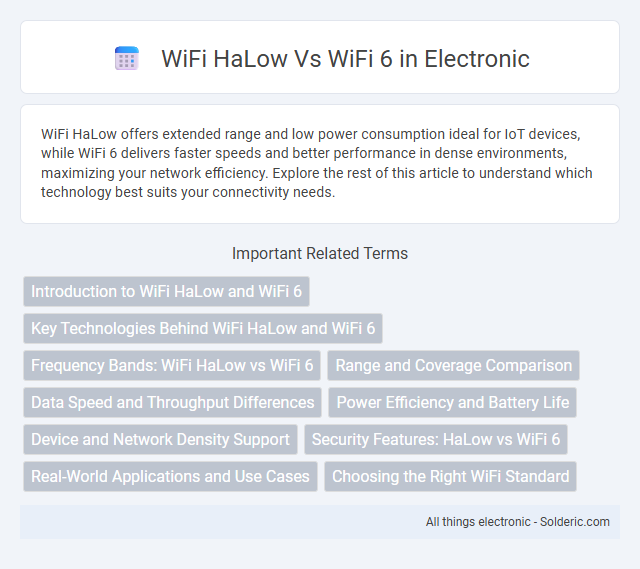WiFi HaLow offers extended range and low power consumption ideal for IoT devices, while WiFi 6 delivers faster speeds and better performance in dense environments, maximizing your network efficiency. Explore the rest of this article to understand which technology best suits your connectivity needs.
Comparison Table
| Feature | WiFi HaLow | WiFi 6 |
|---|---|---|
| Frequency Band | 900 MHz (sub-1 GHz) | 2.4 GHz & 5 GHz |
| Range | Up to 1 km | Up to 100-200 meters |
| Data Rate | Up to 347 Mbps | Up to 9.6 Gbps |
| Power Consumption | Low power, optimized for IoT | Moderate power, designed for high throughput |
| Use Case | IoT devices, sensor networks, rural areas | High-speed internet, dense environments, smartphones |
| Standard | IEEE 802.11ah | IEEE 802.11ax |
| Device Capacity | Supports thousands of devices | Supports high device density with OFDMA |
| Latency | Moderate, suitable for IoT | Low, optimized for real-time applications |
Introduction to WiFi HaLow and WiFi 6
WiFi HaLow operates in the sub-1 GHz spectrum, providing extended range and low power consumption ideal for IoT devices. WiFi 6, based on the IEEE 802.11ax standard, delivers high throughput, improved efficiency, and reduced latency in crowded environments. Both technologies address different connectivity needs: HaLow targets long-range sensor networks, while WiFi 6 focuses on enhanced performance in dense urban and enterprise settings.
Key Technologies Behind WiFi HaLow and WiFi 6
WiFi HaLow leverages IEEE 802.11ah technology, utilizing sub-1 GHz frequencies to provide extended range and low power consumption ideal for IoT devices. WiFi 6, based on IEEE 802.11ax, employs OFDMA, MU-MIMO, and Target Wake Time (TWT) to enhance network efficiency, capacity, and battery life in dense environments. Your choice between these standards depends on whether range and low power for IoT or high throughput and multi-device performance are the priority.
Frequency Bands: WiFi HaLow vs WiFi 6
WiFi HaLow operates in the sub-1 GHz frequency band, typically around 900 MHz, offering extended range and better penetration through obstacles compared to WiFi 6's use of the 2.4 GHz and 5 GHz bands. The lower frequency of WiFi HaLow allows for improved coverage in large indoor and outdoor environments, ideal for IoT and low-power devices. WiFi 6 leverages higher frequency bands to deliver faster data rates but with relatively shorter range and less wall penetration.
Range and Coverage Comparison
WiFi HaLow operates in the sub-1 GHz spectrum, offering significantly extended range and better penetration through walls compared to WiFi 6, which uses higher-frequency bands like 2.4 GHz and 5 GHz. This enables WiFi HaLow to cover larger outdoor areas and reach IoT devices located farther from the router. For your connectivity needs, choosing WiFi HaLow can provide superior coverage in expansive or obstructed environments, while WiFi 6 excels in high-speed performance within shorter ranges.
Data Speed and Throughput Differences
WiFi 6 offers significantly higher data speeds and throughput, reaching up to 9.6 Gbps to support bandwidth-intensive applications and multiple devices simultaneously. WiFi HaLow, operating in the sub-1 GHz spectrum, provides lower data rates typically up to 100 Mbps but excels in longer range and better penetration through obstructions. The trade-off between WiFi HaLow and WiFi 6 lies in optimizing for extended coverage and low power consumption versus maximizing speed and network capacity.
Power Efficiency and Battery Life
WiFi HaLow operates in the sub-1 GHz spectrum, offering significantly lower power consumption compared to WiFi 6, which uses higher frequency bands like 2.4 GHz and 5 GHz. This lower power usage translates to extended battery life for IoT devices and sensors that rely on WiFi HaLow, making it ideal for long-lasting, low-energy applications. Your choice between these technologies should consider the trade-off between HaLow's superior energy efficiency and WiFi 6's higher throughput capabilities.
Device and Network Density Support
WiFi HaLow excels in supporting high device density with extended range and low power consumption, ideal for IoT networks with thousands of connected sensors over large areas. WiFi 6 optimizes network capacity and efficiency for densely populated environments like offices and stadiums, managing simultaneous connections with technologies such as OFDMA and MU-MIMO. Both standards target network density improvement but differ fundamentally in use cases--WiFi HaLow for long-range, low-bandwidth IoT, and WiFi 6 for high-throughput, device-rich environments.
Security Features: HaLow vs WiFi 6
WiFi HaLow offers enhanced security through WPA3 support, improved encryption algorithms, and extended range encryption suited for IoT devices in low-power environments. WiFi 6 also implements WPA3 with individualized data encryption and robust protection against brute-force attacks, optimized for high-density and high-throughput networks. Both standards prioritize advanced authentication protocols, but HaLow's focus lies in securing long-range, low-bandwidth applications, whereas WiFi 6 emphasizes high-speed, secure connectivity for densely populated environments.
Real-World Applications and Use Cases
WiFi HaLow excels in long-range, low-power applications ideal for IoT devices in smart agriculture, industrial automation, and smart cities, providing reliable connectivity over several kilometers with minimal energy consumption. WiFi 6 delivers superior speed, low latency, and high capacity for dense environments like offices, homes, and stadiums, supporting bandwidth-heavy tasks such as video streaming and online gaming. When choosing between WiFi HaLow and WiFi 6, your decision should align with whether your use case prioritizes extended range and battery efficiency or ultra-fast, high-density network performance.
Choosing the Right WiFi Standard
WiFi HaLow excels in long-range, low-power IoT applications, operating in the sub-1 GHz spectrum with extended battery life and penetration through obstacles, ideal for smart agriculture and industrial devices. WiFi 6, based on the 5 GHz and 6 GHz bands, offers higher throughput, lower latency, and enhanced capacity, making it suitable for dense environments like offices and homes requiring fast, reliable connectivity for laptops, smartphones, and streaming devices. Selecting the right WiFi standard depends on prioritizing either range and power efficiency with WiFi HaLow or high-speed, low-latency performance in crowded networks with WiFi 6.
WiFi HaLow vs WiFi 6 Infographic

 solderic.com
solderic.com